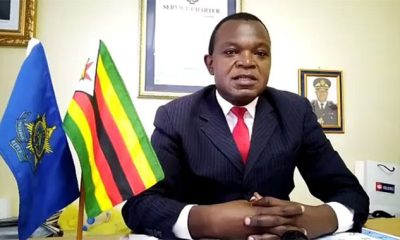THE founder father of Zimbabwe, Dr Joshua Mqabuko Nyongolo Nkomo died in Harare on July 1 after a long battle with prostate cancer and was buried at the national shrine on July 5, 1999.
He was 82.
The largest crowd ever seen at the Heroes’ Acre estimated at nearly 100 000 mourners, including foreign dignitaries, thronged the national shrine to witness the burial of the former Vice-President Dr Joshua Nkomo. Fondly known as Umdala Wethu, Chibwechitedza and Father Zimbabwe, Joshua Nkomo was an icon and a colossus of Zimbabwe’s political history.
Indeed Zimbabweans from all walks of life were united for five days in grief in recognition of a man who knew no cultural boundaries. In mourning, people across the country experienced and lived together Joshua Nkomo’s ideals of peace and harmony regardless of tribe, race or creed.
Record crowds felt obliged to bid farewell to this great son at Barbourfields Stadium and at his home in Bulawayo and at Stodart Hall in Mbare. Joshua Nkomo, the man with a “common touch”, even in death, exhibited his capacity for talking to all types of people in a language they could understand.
Joshua Mqabuko Nyongolo Nkomo was born on June 7, 1917 in Kezi District of Matabeleland. His father Thomas Nyongolo Letswana Nkomo, a prominent community leader and lay preacher of the London Missionary Society (LMS), had two wives and 10 children. Thomas Nyongolo was a teacher trained in South Africa through the assistance of LMS missionaries.
Besides nurturing his children under Christian doctrines, Joshua’s father also inculcated in them a spirit of entrepreneurship, a trait evident in Joshua Nkomo’s adult life.
Joshua was very fond of his mother and says in his autobiography The Story of My Life that he was a late talker and shy child.
“I could not keep up with other children and kept running back to my mother. I adored her; I was a mother’s boy. My weakness made me backward in our games and the sport of stick-fighting. Even when I went to school and found myself coming first in all my classes, from Standard One to Standard Six, I felt the other boys were better than me.
“In later life that lack of confidence has been both my strength and weakness. In my dealings with people I have acted trustingly, and have found out too late when I have been betrayed. My comfort has been to trust in and be trusted by the masses.”
After completing Standard Six at Tsholotsho Government Industrial School, Joshua Nkomo obtained a carpentry certificate at the same institution. He taught carpentry at the LMS-run Manyame School in Kezi as well as Makupa and Izimnyama schools near Plumtree.
Eager to improve his carpentry qualifications, Nkomo enrolled at Adam’s College in Natal, South Africa. On his way to South Africa 1942, he boarded the same train with Enoch Dumbutshena and Herbert Chitepo and it was the former who influenced Joshua Nkomo to join the political sphere. In South Africa he abandoned carpentry in favour of an academic career. On attaining University Junior Certificate (UJC) he proceeded to Jan Hofmeyer School of Social Science in Johannesburg graduating in 1949 with a BA degree in Economics and Social Science. While studying in South Africa, Joshua Nkomo befriended Nelson Mandela and the late President of Botswana, Sir Seretse Khama.

In 1949, he returned home and married Johanna Fuyana (MaFuyana). He joined the Rhodesia Railways as a social welfare officer based in Bulawayo. The post exposed him to huge salary differences between blacks and whites doing similar jobs.
Appalled by such injustices as well as generally poor social conditions under which Africans lived, Joshua Nkomo joined the trade union movement to fight against these conditions. In 1951, he was appointed Secretary of the Railway Workers’ Association. By 1955, he had become the president of the Federation of Africa Workers’ Unions and was inevitably propelled into national politics.
In 1952, Joshua Nkomo was elected President of the African National Congress of Southern Rhodesia. He took advantage of his railway pass to travel throughout the country mobilising the people. The same year he accepted an invitation from Sir Godfrey Huggins, the Prime Minister of Southern Rhodesia to represent African opinion at the London Conference on the proposed federation of the two Rhodesians and Nyasaland. Dr Kenneth Kaunda and Dr Hastings Kamuzu Banda represented Northern Rhodesia and Nyasaland respectively. Joshua Nkomo returned home bitterly opposed to the proposals, but could make no impression in the face of overwhelming European support for the federal concept.
He resigned from Rhodesia Railways in 1954 to start his own business as an auctioneer and insurance agent in Bulawayo, becoming the first African to own such a venture.
The birth of the federation weakened the ANC and Joshua Nkomo set out to rejuvenate the party by incorporating into ANC the more radical National Youth League led by George Nyandoro, James Chikerema, Henry Hamadziripi, Edson Sithole and others.
Events in Ghana, especially the All Africa People’s Congress held in that country in December, 1958 and interaction with other liberation movements around the world had a telling effect on the new course to be taken by ANC. Whereas, the party had hitherto restricted itself to peaceful means of achieving freedom, Joshua Nkomo and other nationalists were running out of patience and were increasingly accepting armed struggle as an alternative means of attaining independence.
The authorities in Southern Rhodesia responded by declaring the first state of emergency in 1959, banned ANC and detained 500 of its members. Cde Nkomo escaped because he was in Egypt at that time.
At the advice of Egyptian friends he opened an external office in London with the objective of stating to the outside world the case of Africans in Southern Rhodesia. For 18 months Joshua Nkomo travelled widely from his London base.
A new party, the National Democratic Party (NDP) was formed in 1960 with Joshua Nkomo as president with the late Leopold Takawira, Morton Malianga, Ndabaningi Sithole and Robert Mugabe as executive members.
In 1961, Nkomo led the NDP delegation of George Silundika, Ndabaningi Sithole and Herbert Chitepo to the Southern Rhodesia Constitutional Conference chaired by then Prime Minister, Sir Edgar Whitehead. The NDP rejected Sir Edgar’s franchise and representation plans and Nkomo led the boycott against the elections emanating from that Constitution. The resultant escalation of civil unrest and tension between NDP and the Government led to the party’s ban in December, 1961.
Cde Nkomo responded by launching the Zimbabwe African People’s Union (Zapu) headed by himself as president and the NDP executives retaining their posts in the new organisation. On September 20, 1962, Zapu too was banned and most of its leaders and members were restricted for three months to their rural places of birth.
Cde Nkomo who was in Zambia at the time Zapu was banned considered establishing a government-in-exile to bring pressure on the Organisation of Africa Unity (OAU), the United Nations and other sympathetic bodies to effect political change at home. His idea was resisted by Rev Ndabaningi Sithole, Enoch Dumbutshena and Tanzanian President Julius Nyerere who felt he should return home to suffer the same restraints as other leaders. He returned home in early 1963 and was immediately restricted at his Kezi home for three months.
On his release he travelled to New York where he addressed the UN Committee in 1963. However, Joshua Nkomo’s idea of government-in-exile brought to the fore internal disputes that had been simmering in the liberation movement for some time.
In July, 1963, in the absence of Joshua Nkomo, who had returned to Southern Rhodesia, the executive members who had remained in Dar-es-Salaam headed by Ndabaningi Sithole, voted to oust Nkomo from leadership.
Cde Nkomo then initiated a new organisation called the People’s Caretaker Council (PCC) which was essentially Zapu under a new name.
The formation of the Zimbabwe African National Union (Zanu) headed by Rev Ndabaningi Sithole in August, 1963 was followed by violent clashes between Zapu and Zanu supporters resulting in both Zanu and PCC being outlawed in 1964.
In April that year Joshua Nkomo was arrested and restricted at Gonakudzingwa Camp and for the next 10 years he was confined at various other places including Gwelo Prison and at Buffalo Range near Chiredzi.
From 1969 he was permitted only three-monthly visits from his wife and their children under 14 years of age.
During these 10 years he appeared in public on three occasions.
Firstly, on October 29, 1965 he was flown to Salisbury to meet British Prime Minister, Harold Wilson on his pre-UDI visit to Salisbury.
The second occasion was in November, 1968 when he was summoned to meet the Commonwealth Secretary General, George Thompson. His last emergence was on February 10, 1972 for an interview with the Peace Commission at Nuanetsi.
About his incarceration he commented: “I would be silly to get anything short of majority rule after suffering all those years.” Without warning, in 1974 he was released and flown to Zambia where the ANC suffered from lack of effective leadership.
A flurry of activity and futile peace efforts that included the Victoria Falls Constitutional Conference with Ian Smith, and a peace shuttle that took him to Malawi, Mozambique, Kenya, Tanzania, London and Salisbury made Joshua conclude to “maintain and escalate the fighting in Rhodesia”.
On October 9, 1976, Zanu and Zapu forged the Patriotic Front Alliance ahead of the Geneva talks scheduled for October 25.
Indeed, the armed struggle escalated with Joshua Nkomo leading the Zimbabwe People’s Revolutionary Army (Zipra) as its Commander-in-Chief.
At Zimbabwe’s first elections in 1980 Cde Joshua Nkomo’s Zapu won 20 seats against Zanu’s 57. He turned down the largely ceremonial post of president before eventually accepting the portfolio of Minister of Home Affairs.

In 1982 Cde Nkomo, together with some of his party members, was dropped from the Government as the country plunged into one of its darkest moments. Civil unrest gripped particularly Matabeleland until 1987 when Zapu and Zanu signed the historic Unity Accord.
During the civil strife, Cde Nkomo briefly went into exile in 1984 only to return a year later to contest the legislative elections when he was elected MP for Magwegwe.
In fact, the quest for unity and peace among Africans was the cornerstone of Joshua Nkomo’s beliefs. As early as 1970 he wrote from prison “. . . disunity has created an international atmosphere that is not favourable to our cause, especially since the rival groups are in reality fighting for the same things. The only difference has been personalities.”
He would comment in 1976 on the Frontline States leaders’ efforts to form a united front between Zanu and Zapu that he was prepared to talk “with whoever the Zanu faction chooses as its leader in an attempt to remove the image of disunity”.
“I regard unity as Zimbabwe’s number one priority, the sine qua non of national happiness. I pray and hope that it will be achieved so that Zimbabwe can become one country for one nation, with opportunities, rights and privileges for everybody: white, yellow, black, Zezuru, Karanga, Manyika, Venda, Kalanga, Tonga, coloured and all,” he wrote in his autobiography.
Cde Joshua Nkomo briefly held the post of Senior Minister in the Government of national unity. From April 1988 until his death, he was Zimbabwe’s Co-Vice President.
In May 1979, Joshua Nkomo was conferred an Honorary Degree of Laws by More House College in Atlanta, Georgia in the USA.
In 1988, he received an Honorary Doctorate in Commerce from Zimbabwe’s National University of Science and Technology (Nust).
At the time of his death, Dr Joshua Mqabuko Nkomo was survived by his wife Johanna Mafuyana, three children and several grandchildren.
Taken from A Guide to Heroes Acre


 Business5 months ago
Business5 months ago
 travel3 weeks ago
travel3 weeks ago
 music2 weeks ago
music2 weeks ago
 money markets2 weeks ago
money markets2 weeks ago
 gospel2 weeks ago
gospel2 weeks ago
 gospel2 weeks ago
gospel2 weeks ago
 gospel2 weeks ago
gospel2 weeks ago






